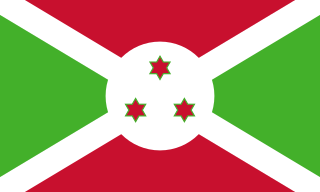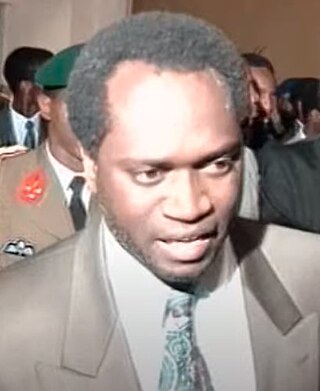Related Research Articles

Burundi originated in the 16th century as a small kingdom in the African Great Lakes region. After European contact, it was united with the Kingdom of Rwanda, becoming the colony of Ruanda-Urundi - first colonised by Germany and then by Belgium. The colony gained independence in 1962, and split once again into Rwanda and Burundi. It is one of the few countries in Africa to be a direct territorial continuation of a pre-colonial era African state.

Melchior Ndadaye was a Burundian banker and politician who became the first democratically elected and first Hutu president of Burundi after winning the landmark 1993 election. Though he attempted to smooth the country's bitter ethnic divide, his reforms antagonised soldiers in the Tutsi-dominated army, and he was assassinated amidst a failed military coup in October 1993, after only three months in office. His assassination sparked an array of brutal tit-for-tat massacres between the Tutsi and Hutu ethnic groups, and ultimately led to the decade-long Burundi Civil War.

The Burundian Civil War was a civil war in Burundi lasting from 1993 to 2005. The civil war was the result of longstanding ethnic divisions between the Hutu and the Tutsi ethnic groups. The conflict began following the first multi-party elections in the country since its independence from Belgium in 1962, and is seen as formally ending with the swearing-in of President Pierre Nkurunziza in August 2005. Children were widely used by both sides in the war. The estimated death toll stands at 300,000.
Antoine Nduwayo was the Prime Minister of Burundi from 22 February 1995, until 31 July 1996. Nduwayo is an ethnic Tutsi.

Pierre Nkurunziza was a Burundian politician who served as the ninth president of Burundi for almost 15 years from August 2005 until his death in June 2020.

The following outline is provided as an overview of and topical guide to Burundi:

Burundi, officially the Republic of Burundi, is a landlocked country in the Great Rift Valley at the junction between the African Great Lakes region and Southeast Africa. It is bordered by Rwanda to the north, Tanzania to the east and southeast, and the Democratic Republic of the Congo to the west; Lake Tanganyika lies along its southwestern border. The capital city is Gitega and the largest city is Bujumbura.

On 25 April 2015, the ruling political party in Burundi, the National Council for the Defense of Democracy – Forces for the Defense of Democracy (CNDD-FDD), announced that the incumbent President of Burundi, Pierre Nkurunziza, would run for a third term in the 2015 presidential election. The announcement sparked protests by those opposed to Nkurunziza seeking a third term in office.

On 21 October 1993, a coup was attempted in Burundi by a Tutsi–dominated army faction. The coup attempt resulted in assassination of Hutu President Melchior Ndadaye and the deaths of other officials in the constitutional line of presidential succession. François Ngeze was presented as the new President of Burundi by the army, but the coup failed under domestic and international pressure, leaving Prime Minister Sylvie Kinigi in charge of the government.

General Évariste Ndayishimiye is a Burundian politician who has served as the tenth President of Burundi since 18 June 2020. He became involved in the rebel National Council for the Defense of Democracy – Forces for the Defense of Democracy during the Burundian Civil War and rose up the ranks of its militia. At the end of the conflict, he entered the Burundian Army and held a number of political offices under the auspices of President Pierre Nkurunziza. Nkurunziza endorsed Ndayishimiye as his successor ahead of the 2020 elections which he won with a large majority.
Interpetrol Burundi S.A. is a Bujumbura-based company that imports and sells petrol in Burundi.
Onatel Burundi, is a state-owned telecommunications provider in Burundi. It provides the full range of services including fixed and mobile voice, broadband and internet. The company has struggled to compete with private internet, broadband and mobile operators for many years.
The Public Transport Office, or OTRACO is a publicly owned enterprise that inspects vehicles and operates public transport in Burundi.
The Société Bouteillerie-Verrerie du Burundi, or Verundi, was a public company that made glass products in Burundi.
The Caisse d'épargne du Burundi, or CADEBU, was a public company that managed mandatory savings in Burundi. It collapsed in 1992 after competition was introduced.
The Caisse de Mobilization et de Financement, or CAMOFI, was a state-owned development bank in Burundi.
The Banque de commerce et de développement, or BCD, was a short-lived state-owned bank in Burundi.
Coopératives d'Épargne et de Crédit, or COOPECs, are microfinance savings and loans cooperatives serving low income people in Burundi. FENACOBU is the umbrella organization for the cooperatives.
The Network of Microfinance Institutions, or RIM is a non-profit association of microfinance institutions in Burundi.
The National Bank for Economic Development is a bank in Burundi.
References
- 1 2 International Science & Technology Institute 1989, p. Annex 6.
- 1 2 3 Nkurunziza, Ndikumana & Nyamoya 2010, p. 39.
- ↑ International Science & Technology Institute 1989, p. v.
- ↑ International Science & Technology Institute 1989, p. 14.
- ↑ Akyeampong & Gates 2012, p. 416.
- ↑ A Hutu for president in Burundi.
- ↑ Burundi Recent Economic Developments.
- ↑ Kibazo 1995.
- ↑ Kwizera 2024.